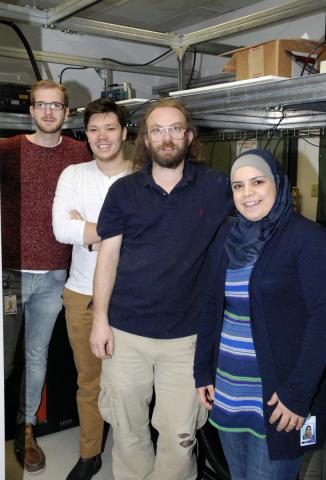
The laser spectroscopy group at TRIUMF, lead by research scientist Matt Pearson and supported by Annika Voss, has recently had its latest paper exploring francium isotopes accepted into Physical Review Letters (PRL). In the paper, three francium isotopes and their isomeric states are explored, as well as a novel technique which was developed for this experiment and paved the way for this recent success.
Francium is an extremely rare element to find in nature and only a fraction of its isotopes that can be artificially produced exist for more than a few minutes. The laser spectroscopy experiment at TRIUMF both produces and investigates francium isotopes with lifetimes of just a few milliseconds. The experiment described in PRL operates by overlapping accelerated ions of francium with laser light of a selected frequency and observing any emitted light (known as fluorescence) when the two interact. This technique probes the energy levels of the valence electrons that are shifted by its overlap with the nuclear core. Measuring the magnitude of these level shifts allows for information on the nuclear properties to be subsequently extracted.
Francium isotopes are extremely interesting to laser nuclear physicists due to their simple atomic structure, with one valence electron, and their large nuclear volumes, which combined allow for high precision investigations into nuclear/electron hyperfine interactions. The neutron-deficient francium isotopes are of particular interest as their nuclei can be modeled using single valence nucleons outside of an inert lead core. By measuring the nuclear properties of these isotopes (and any excited states known as isomers) as neutrons are removed from the system, the validity of the models can be stringently tested.
Recent developments in the field have increased the sensitivity and resolution of new measurements, such as ion bunching and cooling techniques, however, limitations still arose due to an unwanted effect known as optical pumping. When the ions and laser beam are collinearly overlapped, certain atomic levels are depopulated and ‘lost’ to the experiment, lowering the sensitivity and resolution of exotic measurements. To avoid this effect, the laser spectroscopy group at TRIUMF has developed a new technique of high-frequency chopping of continuous-wave laser light with an electro-optic modulator, which is detailed for the first time in the PRL paper.
This chopping technique precisely selects when the laser light and ion bunches interact to minimize and potentially remove any optical pumping effects, as well as lowering the experimental background noise. By removing this effect, the group managed to investigate the 204-, 205- and 206-francium isotopes and distinguish between the observed nuclear ground states and isomers. These results will help to further the understanding of the behavior of nuclear structure in this region of the nuclear chart and showcase the large benefits that the novel chopping technique developed at TRIUMF can offer to future experimental campaigns.
Congratulations to the team for their work and publication of this exciting advancement!
In photo, from right: Walaa Tamimi, Matt Pearson, Allen Leahy and Thomas Procter.
–Thomas Procter, Postdoctoral Fellow, Laser Spectroscopy Group and Melissa Baluk, Communications Coordinator
